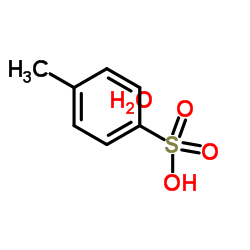p-Toluenesulfonic acid monohydrate

p-Toluenesulfonic acid monohydrate structure
|
Common Name | p-Toluenesulfonic acid monohydrate | ||
|---|---|---|---|---|
| CAS Number | 6192-52-5 | Molecular Weight | 190.217 | |
| Density | 1,24 g/cm3 | Boiling Point | 140°C 20mm | |
| Molecular Formula | C7H10O4S | Melting Point | 96-99 °C(lit.) | |
| MSDS | Chinese USA | Flash Point | 180 °C | |
| Symbol |


GHS05, GHS07 |
Signal Word | Danger | |
|
A BODIPY-luminol chemiluminescent resonance energy-transfer (CRET) cassette for imaging of cellular superoxide.
Org. Biomol. Chem. 13(6) , 1763-7, (2015) Spectroscopic and in cellulo studies are here reported on the very first BODIPY-luminol chemiluminescent resonance energy-transfer (CRET) cassette where the luminol CL agent is covalently linked to the BODIPY energy-transfer acceptor in a molecular dyad. The ... |
|
|
The Role of Charge Density and Hydrophobicity on the Biocidal Properties of Self-Protonable Polymeric Materials.
Macromol. Biosci. 15 , 927-40, (2015) Intrinsic antimicrobial thermoplastic A(BC)n copolymers (n = 1, 2, 4), where A was poly(ethylene glycol) (PEG), BC was a random chain of methylmethacrylate (MMA), and alkyl-aminoethyl methacrylate (AAEMA), were synthesized and the antimicrobial activity and h... |
|
|
Octadecyl ferulate behavior in 1,2-Dioleoylphosphocholine liposomes.
Spectrochim. Acta. A. Mol. Biomol. Spectrosc. 153 , 333-43, (2015) Octadecyl ferulate was prepared using solid acid catalyst, monitored using Supercritical Fluid Chromatography and purified to a 42% yield. Differential scanning calorimetry measurements determined octadecyl ferulate to have melting/solidification phase transi... |
|
|
Salt Stability - The Effect of pHmax on Salt to Free Base Conversion.
Pharm. Res. 32 , 3110-8, (2015) The aim of this study was to investigate how the disproportionation process can be impacted by the properties of the salt, specifically pHmax.Five miconazole salts and four sertraline salts were selected for this study. The extent of conversion was quantified... |
|
|
Homogeneous detection of caspase-3 using intrinsic fluorescence resonance energy transfer (iFRET).
Biosens. Bioelectron. 67 , 413-8, (2015) Caspase-3 is an apoptotic cysteine protease and its aberrancy is highly implicated to numerous diseases thereby rendering caspase-3 activity as an important disease marker. Most caspase-3 sensors are caspase-3 substrates of which the fluorescence signals are ... |
|
|
Hierarchically functionalized magnetic core/multishell particles and their postsynthetic conversion to polymer capsules.
ACS Nano 9 , 4219-26, (2015) The controlled synthesis of hierarchically functionalized core/multishell particles is highly desirable for applications in medicine, catalysis, and separation. Here, we describe the synthesis of hierarchically structured metal-organic framework multishells a... |
|
|
Effects of the addition of dimer acid alkyl esters on the properties of ethyl cellulose.
Carbohydr. Polym. 121 , 284-94, (2015) In this study, we synthesized dimer acid (DA) esters, having short to long alkyl chains, (DA-Cn) by the Diels-Alder reaction and subsequent esterification reaction of fatty acids that were prepared by the hydrolysis of waste vegetable oil. It was found that t... |
|
|
A New Green Ionic Liquid-Based Corrosion Inhibitor for Steel in Acidic Environments.
Molecules 20 , 11131-53, (2015) This work examines the use of new hydrophobic ionic liquid derivatives, namely octadecylammonium tosylate (ODA-TS) and oleylammonium tosylate (OA-TS) for corrosion protection of steel in 1 M hydrochloric acid solution. Their chemical structures were determine... |
|
|
Supported p-toluenesulfonic acid as a highly robust and eco-friendly isocyanide scavenger.
ACS Comb. Sci. 13(1) , 89-95, (2011) We document here the use of polymer-supported p-toluenesulfonic acid as a highly effective, robust, economical and eco-friendly isocyanide scavenger. The herein described strategy circumvent the intense and repulsive odor of volatile isocyanides, enabling sim... |
|
|
The transporter-opsin-G protein-coupled receptor (TOG) superfamily.
FEBS J. 280(22) , 5780-800, (2013) Visual rhodopsins are recognized members of the large and diverse family of G protein-coupled receptors (GPCRs), but their evolutionary origin and relationships to other proteins are not known. In a previous paper [Shlykov MA, Zheng WH, Chen JS & Saier MH Jr ... |